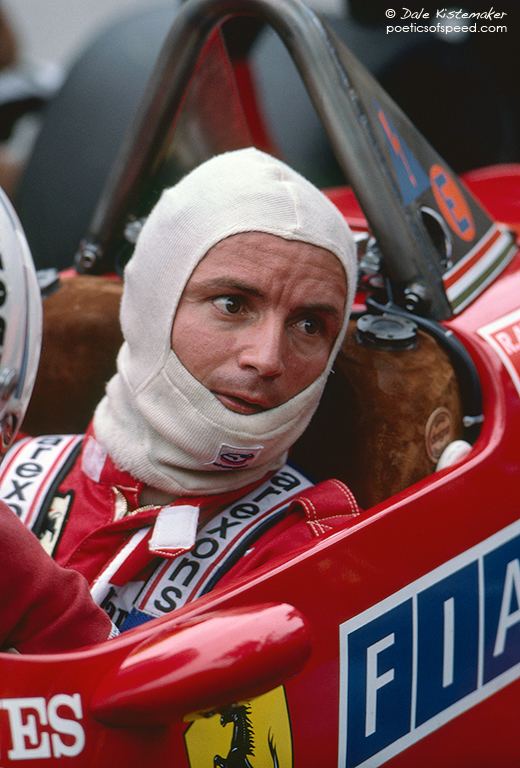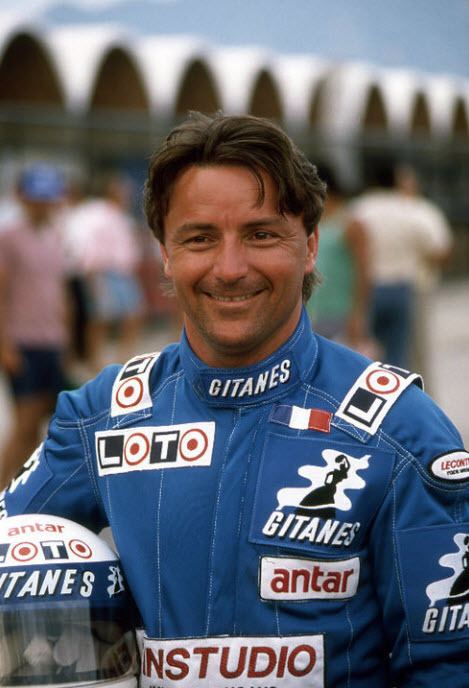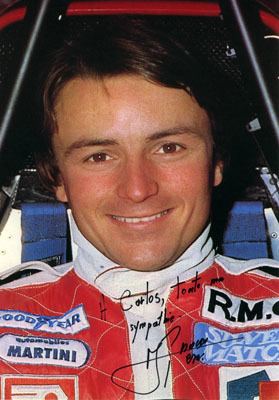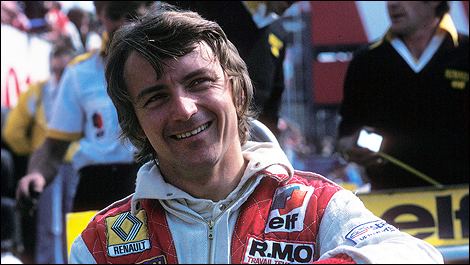Nationality French Wins 7 Active years 1978–1989 Name Rene Arnoux | Entries 165 (149 starts) Role Racing driver Championships 0 Organizations founded DAMS | |
 | ||
Similar People Profiles | ||
Tribute to ren arnoux
René Alexandre Arnoux (born 4 July 1948) is a French former racing driver who competed in 12 Formula One seasons (1978 to 1989). He participated in 165 World Championship Grands Prix (149 starts) winning seven of them, achieving 22 podium finishes and scoring 181 career points. His best finish in the World Drivers' Championship was third in 1983 for Ferrari. In 1977, Arnoux won the European Formula Two Championship. In 2006 he raced in the inaugural season of the Grand Prix Masters series for retired F1 drivers.
Contents
- Tribute to ren arnoux
- Ren Arnoux visits Ferrari
- Early career
- Martini Surtees
- Renault
- Ferrari
- Ligier
- Post career
- Complete Formula One World Championship results
- Non Championship results
- References

René Arnoux visits Ferrari
Early career

Arnoux's career began in Formule Renault and he first moved into Formula Two in 1974 with Elf, taking fourth place on his debut at Nogaro. In 1975 he moved to Formule Super Renault and won the title. For 1976, Arnoux moved back to Formula Two with an Elf-sponsored, works Martini-Renault, winning three races and narrowly losing the title to Jean-Pierre Jabouille. However, he won the 1977 European Championship, again driving a Martini-Renault. Arnoux won races at Silverstone, Hockenheim, Pau and Nogaro, which along with second places at Enna-Pergusa and Estoril saw him finish 12 points clear of American Eddie Cheever who was driving for Ron Dennis' Project Four Racing, and 14 points clear of team mate Didier Pironi.
Martini / Surtees

Arnoux continued with the Martini team when it made the transition to Formula One in 1978. However, in an organisation with insufficient means to compete in the highest echelon of the sport, Arnoux was unable to demonstrate his abilities and Martini abandoned Formula One during the season, having run short of money. Arnoux's best finishes for Martini were two 9th places in Belgium and Austria. He failed to qualify in South Africa, and failed to pre-qualify in Monaco and Germany.

Arnoux moved to Surtees for the last two races of the season, but once again found himself in a team on the edge of failure. Unlike team owner John Surtees who had won the F1 World Championship in 1964, Team Surtees was rarely a front runner in Grand Prix racing. In his two races for the team Arnoux's best finish was his first race where he placed 9th at Watkins Glen for the United States Grand Prix. Arnoux qualified the Surtees TS20 in 21st place at Watkins Glen, while team mate Beppe Gabbiani failed to qualify. His last race for the team in Canada saw him qualify an encouraging 16th but retire just after half distance when the Ford DFV engine failed. Surtees would have liked to sign Arnoux on a permanent basis, but his few drives to date had demonstrated his potential to bigger teams and Arnoux signed with Renault for 1979.
Renault

In the 1979 season, the factory Renault team entered two cars for the first time since its debut in 1977. The team's only victory of the year was taken by Arnoux's team mate Jean-Pierre Jabouille at the French Grand Prix at the Dijon-Prenois circuit, but Arnoux took the headlines due to a fierce, but good-natured wheel-banging battle with the Flat-12 Ferrari of Gilles Villeneuve for second place. Ultimately Villeneuve would just hold off Arnoux to take second place. Arnoux began to fulfil his potential in the second half of the season with 4 top-six finishes (3 podium places) whereas Jabouille's Dijon victory was his only points finish of the year.

In 1980, Arnoux took his first two Formula One victories, the first being at a much-protested Interlagos circuit in Brazil but a lack of reliability prevented him from playing a part in the fight for the world title, although he took three pole positions. His second win came in the very next race at the Kyalami circuit in South Africa where the thinner air at high altitude saw the turbocharged Renault RE20 have a power advantage over its mostly Cosworth powered rivals. At that point in the season Arnoux was leading the World Championship for the first time. He would not lose the championship lead until Round 6 in Monaco. The season though was punctuated by unreliability from the turbocharged Renault V6 engine, though progress was rapidly moving forward with the V6 proving powerful, producing approximately 510 bhp (380 kW; 517 PS) to be on par with Ferrari (and considerably more powerful than the 475 bhp (354 kW; 482 PS) Ford DFV). What generally hurt the Renaults was unreliability, and the lack of ground effects. Although he would later finish in a fine second in the Dutch Grand Prix at Zandvoort, he would finish the season in 6th place with 29 points, 38 points behind World Champion Alan Jones.
Arnoux's situation was complicated in 1981 by the arrival of Alain Prost at Renault. Inevitably their rivalry on track flared up off the track and relations between the two men deteriorated, dividing the small world of French motorsport. The conflict reached its peak at the 1982 French Grand Prix at the Circuit Paul Ricard. The drivers took the first one-two in Renault's history in Formula One, Arnoux finishing ahead of Prost. Prost was furious, considering that his team mate had not kept to the team orders agreed before the race, according to which he should have ceded the win to Prost, who was better placed in the 1982 championship. Arnoux replied that no orders had been given before the race and that he was free to drive his own race. He took one other win at the Italian Grand Prix at the end of the season. He was also lucky to walk away from a high speed crash after losing a wheel going into the banked Tarzan corner at the end of the long straight in the 1982 Dutch Grand Prix, though luckily his car's momentum was largely stopped by the sand trap and tyre barrier.
Ferrari
The pairing of Prost and Arnoux having become unsustainable, Arnoux left Renault at the end of 1982 to join the other factory team in Formula One, Ferrari in 1983, joining another French driver Patrick Tambay. With three victories, at the Canadian, German, and Dutch Grands Prix, he was in contention for the world title for much of the season, but was left behind by his rivals Prost and Nelson Piquet in the championship run in. Both Arnoux and Tambay became favourites with the Tifosi for their hard charging styles and results saw Ferrari win the Constructors' Championship. Arnoux's win at Zandvoort would prove to be the 7th and last win of his Formula One career.
With the McLarens of Prost and Niki Lauda dominating 1984, Arnoux had a less successful second season at Ferrari, only finishing 6th with 27 points, with his new team mate Michele Alboreto progressively taking the initiative and team leadership from him. After three wins and four pole positions in 1983, Arnoux failed to win or claim a pole position in 1984 (Alboreto won the Belgian Grand Prix from pole with Arnoux starting second and finishing third), though he still drove well on occasions, finishing second in San Marino and Dallas where he was forced to start from the pits due to an electrical fault on the warm up lap and managed to keep his car out of trouble on the crumbling track. The only Grand Prix ever held in Dallas was also the last time Arnoux achieved a Formula One podium finish. As the season progressed, Arnoux appeared to lack motivation and after finishing 4th in the opening race of the 1985 championship in Brazil, an 'amicable separation' was agreed between him and Ferrari. His place in the team was taken by Swedish driver Stefan Johansson. He was seen in the Brabham pits at Imola in Round 3, sparking rumours he was set to join the team then owned by Bernie Ecclestone, but nothing came of it and he was rarely seen at races for the rest of the season.
Ligier
Without a drive for the rest of the 1985 season, Arnoux made his return to Formula One in 1986 for the French Ligier team who were using turbocharged Renault engines, where he delivered several good performances. However, despite maintaining his motivation, the Pirelli-tyred Ligiers were not competitive as the season progressed. Arnoux had two team mates in 1986. For the first half of the season his team mate was French driver Jacques Laffite. However, Laffite's career ended when he broke both of his legs in a first corner crash at Brands Hatch in the British Grand Prix. From the following race Laffite was replaced with yet another French driver, the fast but accident prone Philippe Alliot.
For 1987, Ligier were to have exclusive use of a new, 850 bhp (634 kW; 862 PS) four-cylinder turbocharged Alfa Romeo engine in the new Ligier JS29. However, after Arnoux compared the engine to used food during pre-season testing, Alfa's parent company Fiat pulled the plug on the project and Ligier were forced into using the four-cylinder Megatron engines for the season and there was little to show for it in the way of results despite the Megatron (the old BMW M12/13 engine) producing around 950 bhp (708 kW; 963 PS). Arnoux scored the team's only point during the season with a 6th place in Belgium. The race at Spa also saw the best finish for his team mate Piercarlo Ghinzani who finished 7th.
1988 was to prove the final year for turbos in Formula One and Ligier took the chance to race the new, 3.5-litre Judd V8 engine. The Ligier JS31 proved to be a disaster though with both Arnoux and new team mate Stefan Johansson struggling, often only just making it onto the grid or simply failing to qualify, with both drivers often complaining that even in dry conditions the lack of grip saw them forced to drive with a wet weather technique. Although he only failed to qualify twice during the season (San Marino and France – Johansson failed to make the grid 6 times), his best finish of the year was a disappointing 10th place in the Portuguese Grand Prix. It was the first time since his debut season in 1978 that Arnoux failed to score a World Championship point. His DNQ at Imola was the first time he had failed to qualify for a race since the 1981 Belgian Grand Prix. His season finished on a sour note when he took out race leader Gerhard Berger while being lapped at the 1988 Australian Grand Prix (though of all the experts and commentators who blamed Arnoux for taking out Berger's Ferrari in Adelaide and ruining the race as a spectacle, Berger himself refused to do so, citing a "very long" brake pedal after his hot pace which meant he couldn't stop to avoid Arnoux, nor pass him more easily as he normally would have. He also cited the fact that with his turbo boost turned up to full, the Ferrari would have run out of fuel long before the race ended).
Arnoux's fall to the back of the grid didn't change in 1989, despite the new Ford DFR powered Ligier JS33 showing promise. Towards the end of his career, Arnoux had attracted some controversy; he was frequently accused of not using his mirrors and blocking faster cars in qualifying and when being lapped (a trait he seemingly passed on to his 1989 rookie team mate Olivier Grouillard), even taking off a number of cars as well. During the 1989 Monaco Grand Prix, BBC commentator Murray Walker remarked that Arnoux's claimed reason for going so slow at that stage of his career was that he was used to turbo powered cars and that the naturally aspirated cars were "a completely different kettle of fish to drive — he says". Walker's co-commentator, 1976 World Champion James Hunt's reply was typically blunt as he said "And all I can say to that is bullshit" (Hunt had raced 'atmo' cars in his career). Arnoux received criticism after the race for continually ignoring the blue flags, with former Renault team mate Prost in particular held up by the Ligier which refused to let the McLaren past for a number of laps. This cost Prost some 20 seconds in his pursuit of team mate Ayrton Senna and for a number of laps the Ligier had a crocodile line of cars behind him as he refused to move over and let faster cars through.
Arnoux finished his career with 181 World Championship points, with his last points coming from a 5th place at the 1989 Canadian Grand Prix. His last race was the very wet 1989 Australian Grand Prix in Adelaide where his Ligier was pushed into retirement by the Arrows of Eddie Cheever after just 4 laps. Showing he still had skill as a driver, Arnoux was second fastest to the McLaren-Honda of outgoing World Champion, pole man and acknowledged rain master Ayrton Senna in the extra half-hour warm-up that was scheduled to let drivers and teams set up their cars for what would be a wet race after three days of typically sunny Australian weather.
Post career
René Arnoux has since started an indoor karting business called Kart'in, consisting of four tracks in France, two in the Parisian area, one in the suburbs of Lyons and one near Marseille. He also owns and manages two factories, frequently appears and drives in historical events on behalf of Renault and resides in Paris.
Arnoux was one of the drivers invited to take part in the Grand Prix Masters championship in 2006 and 2007, restricted to former Formula One drivers. In 2007 and 2008 he drove for the Renault H&C Classic Team, when he presented and drove Alain Prost's F1 car from 1983 at World Series by Renault events.
Complete Formula One World Championship results
(key) (Races in bold indicate pole position, Races in italics indicate fastest lap)
Non-Championship results
(key) (Races in bold indicate pole position) (Races in italics indicate fastest lap)
